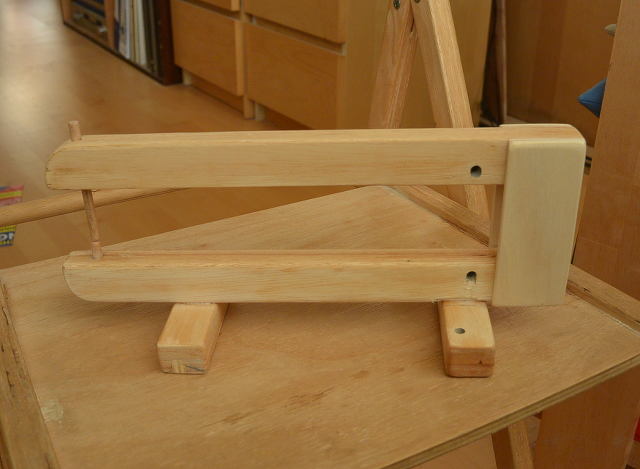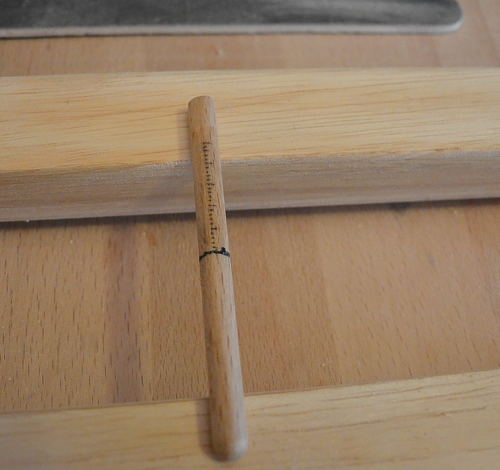Page 1 of 1
Thickness gauges, a little bit of brainstorming
Posted: Mon Jul 31, 2017 5:14 pm
by Beate Ritzert
Although it is possible to build an archtop guitar without using a (dedicated...) thickness gauge, i would like to avoid the improvised solution i used 30 years ago.
Which means making a thickness gauge. I found various ideas, most of them using a dial indicator, but on the other extreme gauges with just a moveable dowel carrying some scale. The one proposed by in Benedetto's book belongs in this class, but of course even simpler constructs can be imagined. And simple constructs with mechanical magnification of the movement. The most simple construction uses just a moveable dowel. That approach even has the advantage that the dowel can easily be replaced by a pencil in order to show the contours during work.
And this leaves a few questions:
- which precision do we actually need for which purpose (arched plates, plane plates and ribs)? Without using mechanical magnification obtaining better than 0.5 mm would become pretty hard, even if we consider an additional nonius scale. (we might replace the dowel by a screw?)
The precision of a typical indicator screw is a bit of overkill, isn't it? And not achievable in practice anyway?
- what's the best measurement range for our purposes? min 1 mm, and max? 10 mm because dial indicators for that max thickness can be bought cheapest? Or do we need to be able to measure the thickness of the plate before carving?
- which depth of the opening are ideal for out purposes? 200 mm, 250 mm, 300 mm?
- which height of the open would be ideal?
BTW: i am seeking the simplest adequate solution, and, just for the fun of it i'm considering something like a dowel or a screw in connection with some mechanical magnification, maybe made from rests of plywood.
Re: Thickness gauges, a little bit of brainstorming
Posted: Mon Jul 31, 2017 8:22 pm
by Barry Daniels
Dial gauges made in China can be had for $10 or $15 bucks so there is no reason not to use one. The precision is more than you need but a dowel has less precision than you need and is way too fussy in use. I use a 0 to 1" caliper which is about perfect. You don't need a caliper for the plate before carving.
I made the handle for mine from some 1/2" baltic birch plywood. I can get a picture of it if you need it.
Re: Thickness gauges, a little bit of brainstorming
Posted: Tue Aug 01, 2017 2:49 pm
by Beate Ritzert
Barry Daniels wrote:Dial gauges made in China can be had for $10 or $15 bucks so there is no reason not to use one.
I know.
But i am somehow fascinated from the older constructions with pointer devices improving the resolution.
Anyway, although making such a C bow is pretty straightforward (and i have seen lots of pictures) i am interested in opinions about good dimensions in the sense of "not too small, not too large".
And i am even more fascinated from the simple tool Stradivari used to mark the depth of the inner part of the plates - the "graduation punch".
Maybe this is what i'd build first - i do not own a drill press.
Re: Thickness gauges, a little bit of brainstorming
Posted: Sat Aug 05, 2017 4:11 am
by Beate Ritzert
Those cheap dial gauges all have a range of up to 10 mm, which may be a bit small. And gauges with a range of 20 mm or 30 mm are harder to find and more expensive.
Just another idea to keep it as simple as possible: use a screw M6 (metric with a diameter of 6 mm) or M7. One turn changes the distance by exactly 1 mm. That gives a resolution of 0.1 mm or better. You have to count the turns - but that is necessary for dial gauges and dial screws as well.
For better resolution use a screw M3 which has a pitch of 0.5 mm.
Re: Thickness gauges, a little bit of brainstorming
Posted: Sat Aug 05, 2017 9:26 am
by Barry Daniels
The dial gauge I use counts the turns for you. Or even better, get a digital caliper:
https://www.amazon.com/Neoteck-Indicato ... dial+gauge
Re: Thickness gauges, a little bit of brainstorming
Posted: Sat Nov 11, 2017 12:19 am
by Matthew Lau
Barry, can I get pictures?
I have a mitutoyo digital dial gauge that I think would be perfect for this--just not sure how to implement it.
Re: Thickness gauges, a little bit of brainstorming
Posted: Sat Nov 11, 2017 11:30 am
by Clay Schaeffer
If you could fasten a pocket rule graduated in mm's to the face of the (square) dowel and make a vernier that would read against it you could make a caliper reading to 1/10 mm without too much of a problem.
Re: Thickness gauges, a little bit of brainstorming
Posted: Sat Nov 11, 2017 4:28 pm
by Brian Evans
In use, part of the issue is getting the indicator to move very freely over the roughed out wood surface without grabbing. the pointer of a dial indicator is perfect for this - the spring is very light, the movement of the rod is very smooth, and the accuracy is .001". I made a "C" out of plain old 3/4" plywood about 10" deep, mounted the dial indicator (a $15 1" travel indicator is fine) on the upper arm of the C, and put an adjustable anvil on the bottom, a 1/4" bolt threaded through the wood with a lock nut, the end of the bolt sticking up about an inch and rounded to semi-spherical so it rides over the rough wood easily as well. In use I mount the lower arm of the C in a vise, and rest the plate on the anvil and just slide the plate around to see what the thickness is. The dial indicator has a sub-dial that reads in 10ths of an inch, and a full 360 degree sweep of the dial is also 1/10". When finishing a plate I like to use it when roughing to get close, then I use it to get within .010" of my target graduations, then I sand and smooth. I already had the dial indicator, the plywood and the bolt, so my gauge cost me nothing.
Brian
Re: Thickness gauges, a little bit of brainstorming
Posted: Sat Nov 11, 2017 9:33 pm
by Barry Daniels
Here is my jig. It's made out of 5/8" (16 mm) thick baltic birch which is a little bit flexible. But it holds an accuracy of probably plus or minus two thousandths, which is close enough for me.
Re: Thickness gauges, a little bit of brainstorming
Posted: Sat Nov 11, 2017 9:35 pm
by Barry Daniels
The caliper is installed in a hole and a saw kerf down the middle allows it to clamp onto the caliper's housing with a couple of bolts.
Re: Thickness gauges, a little bit of brainstorming
Posted: Sat Nov 11, 2017 9:37 pm
by Barry Daniels
A threaded brass post screws into the bottom leg to provide an adjustable post.
Re: Thickness gauges, a little bit of brainstorming
Posted: Sat Nov 11, 2017 9:39 pm
by Barry Daniels
A couple of brass strips were added that house some plastic wheels from the hardware store. A string is guided though the wheels to lift the caliper's post. I had to drill a hole through the top of the post to thread the string through it. The string is just a cotton string that is not very strong, but it is held up in this jig for over 15 years.
Re: Thickness gauges, a little bit of brainstorming
Posted: Sat Nov 11, 2017 9:41 pm
by Barry Daniels
Here is a view of the back to show the internals of the lifting mechanism.
Re: Thickness gauges, a little bit of brainstorming
Posted: Sat Nov 11, 2017 9:44 pm
by Barry Daniels
One more photo to show the trigger. It's just a twisted piece of brass with a nut to provide a pivot and a hole to tie the string to. This thing might look a bit Rube Goldbergish, but it works quite well. I'm sure someone could come up with a better lifting mechanism, but when I made this I didn't have the metal working capability to pull off something more elegant.
Re: Thickness gauges, a little bit of brainstorming
Posted: Wed Dec 06, 2017 2:44 am
by Matthew Lau
Very clever.
I'll make a version with my dial caliper some day, buy will be using one I bought off eBay in the meantime.
Re: Thickness gauges, a little bit of brainstorming
Posted: Wed Dec 06, 2017 12:35 pm
by Brian Evans
Mine is functionally the same as Barry's but I made it to be mounted in a vise to use. That means I don't need a lift mechanism because I have the plate in one hand, lift the plunger with the other and the gauge is solid and stable in the vise. I found when I tried to use it free-hand the wooden "C" wasn't stiff enough and I got too much flexing - maybe up to 5 or 10 thou! The horrors.... Anyway, I tend to carve to within 10 - 20 thou of target thickness, which is typically .200 on the middle of the plate before finish sanding. You can get that level of accuracy with a lever based spring loaded finger indicator, if you use enough length on the pointer.
Re: Thickness gauges, a little bit of brainstorming
Posted: Mon Feb 12, 2018 12:24 pm
by Beate Ritzert
Well, here it is. I decided for a really simplistic approach - much simpler than the one in Benedetto's book, but same precision. Dimensions have been taken from Benedettos's gauge. IMO sufficient for rough carving of violin and archtop plates. If i need more precise readings i can add a nonius scale relatively easy.
It has bee build from the rests of an irrepairably broken cheap folding chair - same model as the one it is standing on on the picture.


Re: Thickness gauges, a little bit of brainstorming
Posted: Tue Feb 20, 2018 3:58 pm
by Matthew Lau
Nice, clean execution.